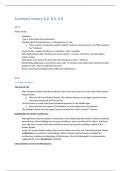Summary history 6.2, 6.5, 6.6
CP T1:
There will be:
- Definition
- True or False about the Renaissance
- Painting about the Renaissance. Is it Renaissance or not.
o Three reasons: perspective, depth, realistic, anatomy, about humans. YesRenaissance.
No? Medieval.
- Correct order: voyages of discovery: Columbus, , Dias, Magellan.
- Why did Europeans like Columbus set out to explore. 3 reasons. Adventure, spread religion,
money, power
- Why did so many Aztecs die when die when Europeans came? disease.
- Relationship dying Aztecs and African slave trade because many Aztecs died, Spanish needed
people to work. They brought African slaves.
- Bonus: Good Feyenoordlogo OR my little pony OR Dinosaur
Book:
6.2 Antiquity Reborn
The Eternal City
- When Emperor Hadrian had the Pantheon, there were more than one and a half million people
living in Rome.
o After the fall of the Roman Empire, life in Rome became increasingly unsafe and more
and more people left the Eternal city.
- Yet there were a reason why Rome remained important in the Middle Ages.
o Rome became the capital of Christianity, the only religion that was allowed.
- The bishop of Rome (now the pope), became head of the Church in the 4 th century.
Building like the Greeks and Romans
- Although Rome was the capital of Christianity in the Middle Ages the decline of Rome continued
nevertheless. Many buildings were in poor conditions, and so was the old St. Peter’s. But there
were still many remains that show that Rome once had been the wealthiest capital of the
Roman Empire.
- In the 14th century Italian trading cities such as Venice were very rich. They took ancient Roman
architecture as a model for new buildings. Other architects and artists also imitated the
architecture, sculpture and paintings of the Romans. One of Michelangelo’s contemporaries
suggested the name Renaissance. (Rebirth)
Characteristics of art in the Renaissance
, - In Italy due to the many remains from the age or the Romans in that country.
- Some characteristics of Renaissance art:
o The interest in anatomy
o In our eyes, the proportions in medieval paintings don’t seem right. A Greek
mathematician already figured out that this has to do with perspective.
6.5 Voyages of discovery
New routes to the Indies
- Travelling across sea was very dangerous. But in the days of Henry the Navigator voyages of
discovery were made possible by improved sailing techniques and ships.
- Navigational instruments were introduced, such as magnetic compass: You didn’t had to follow
the coastline any more.
- Better maps were made because of Ptolemy’s new descriptions.
o Rocks, swallows were on maps became more accurate.
- There were quite a few explorers who were brave enough to find new routes to the islands.
o Portuguese: Looking for a new route along the coast of Africa, Bartholomeus Diaz was
the first one to come to Cape of good hope, on this trip
Vasco da Gama was the first one to sail round this dangerous cape in 1498. He
sailed across the Indian Ocean, after which he reached the Indies.
In 1492, Christopher Columbus (who was hired by the Spaniards) had tried a
totally different route. His logical was easy: If the earth is round I can get there
by two ways. After crossing the Atlantic, het thought he reached the Indies,
after his death, it was clear that he discovered America.
Later the Dutchman Willem Barentsz attempted to reach the Indies across the
Arctic Ocean.
Contacts all over the world
- As a result of the discoveries, Europeans began to trade in Asia, Africa and South America, the
Portuguese built trading posts, they seldom travelled inland. The Europeans bought the goods
from indigenous rulers and merchants.
- Sometimes the Europeans enforced advantageous trading conditions by using violence.
- Some parts of continents for example America became colonies. The rulers started plantations
in the colonies.
Missionaries
- Spaniards had other intentions in addition to making much money out of the colonies. Spanish
missionaries went to America, too. Priests came to convert the natives to Christianity.
- First, the American slaves had to work on plantations and in the mines, but as a result of this
forced labour and new European diseased many American Indians died.
o However, this didn’t bring an end to forced labour: the Spaniards and Portuguese
brought new slaves from Africa this is how slave trade began. Later the Netherlands
would also play a major role in this.





